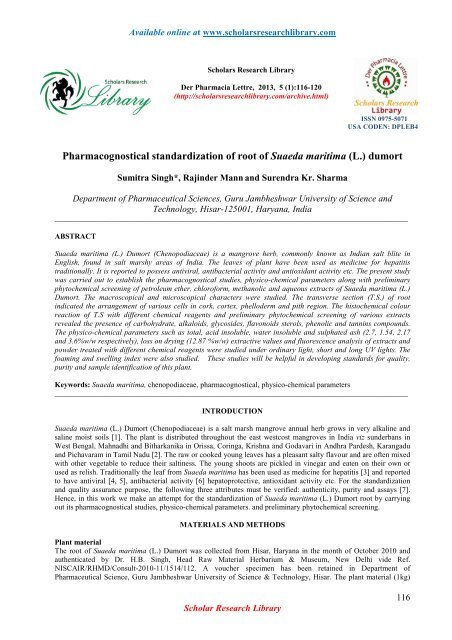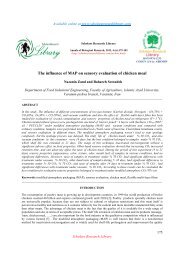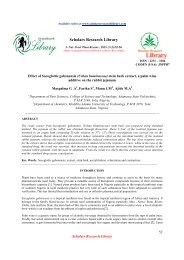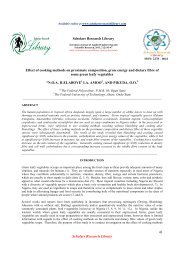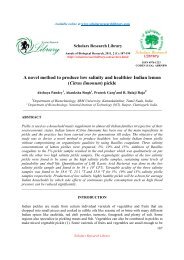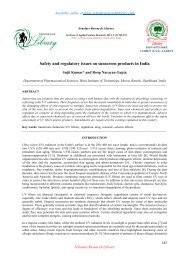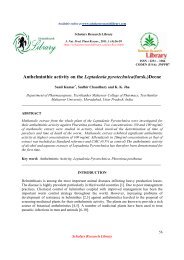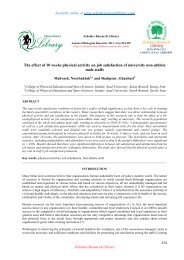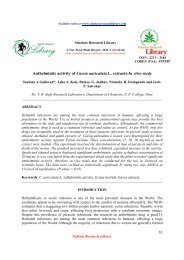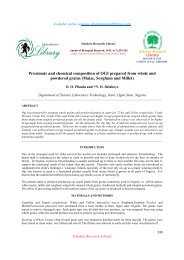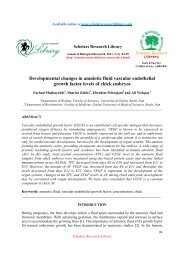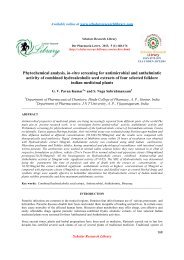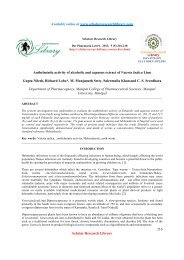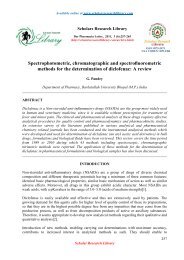Pharmacognostical standardization of root of Suaeda maritima (L ...
Pharmacognostical standardization of root of Suaeda maritima (L ...
Pharmacognostical standardization of root of Suaeda maritima (L ...
Create successful ePaper yourself
Turn your PDF publications into a flip-book with our unique Google optimized e-Paper software.
Available online at www.scholarsresearchlibrary.com<br />
Scholars Research Library<br />
Der Pharmacia Lettre, 2013, 5 (1):116-120<br />
(http://scholarsresearchlibrary.com/archive.html)<br />
ISSN 0975-5071<br />
USA CODEN: DPLEB4<br />
<strong>Pharmacognostical</strong> <strong>standardization</strong> <strong>of</strong> <strong>root</strong> <strong>of</strong> <strong>Suaeda</strong> <strong>maritima</strong> (L.) dumort<br />
Sumitra Singh*, Rajinder Mann and Surendra Kr. Sharma<br />
Department <strong>of</strong> Pharmaceutical Sciences, Guru Jambheshwar University <strong>of</strong> Science and<br />
Technology, Hisar-125001, Haryana, India<br />
_____________________________________________________________________________________________<br />
ABSTRACT<br />
<strong>Suaeda</strong> <strong>maritima</strong> (L.) Dumort (Chenopodiaceae) is a mangrove herb, commonly known as Indian salt blite in<br />
English, found in salt marshy areas <strong>of</strong> India. The leaves <strong>of</strong> plant have been used as medicine for hepatitis<br />
traditionally. It is reported to possess antiviral, antibacterial activity and antioxidant activity etc. The present study<br />
was carried out to establish the pharmacognostical studies, physico-chemical parameters along with preliminary<br />
phytochemical screening <strong>of</strong> petroleum ether, chlor<strong>of</strong>orm, methanolic and aqueous extracts <strong>of</strong> <strong>Suaeda</strong> <strong>maritima</strong> (L.)<br />
Dumort. The macroscopical and microscopical characters were studied. The transverse section (T.S.) <strong>of</strong> <strong>root</strong><br />
indicated the arrangement <strong>of</strong> various cells in cork, cortex, phelloderm and pith region. The histochemical colour<br />
reaction <strong>of</strong> T.S with different chemical reagents and preliminary phytochemical screening <strong>of</strong> various extracts<br />
revealed the presence <strong>of</strong> carbohydrate, alkaloids, glycosides, flavonoids sterols, phenolic and tannins compounds.<br />
The physico-chemical parameters such as total, acid insoluble, water insoluble and sulphated ash (2.7, 1.54, 2.17<br />
and 3.6%w/w respectively), loss on drying (12.87 %w/w) extractive values and fluorescence analysis <strong>of</strong> extracts and<br />
powder treated with different chemical reagents were studied under ordinary light, short and long UV lights. The<br />
foaming and swelling index were also studied. These studies will be helpful in developing standards for quality,<br />
purity and sample identification <strong>of</strong> this plant.<br />
Keywords: <strong>Suaeda</strong> <strong>maritima</strong>, chenopodiaceae, pharmacognostical, physico-chemical parameters<br />
_____________________________________________________________________________________________<br />
INTRODUCTION<br />
<strong>Suaeda</strong> <strong>maritima</strong> (L.) Dumort (Chenopodiaceae) is a salt marsh mangrove annual herb grows in very alkaline and<br />
saline moist soils [1]. The plant is distributed throughout the east westcost mangroves in India viz sunderbans in<br />
West Bengal, Mahnadhi and Bitharkanika in Orissa, Coringa, Krishna and Godavari in Andhra Pardesh, Karangadu<br />
and Pichavaram in Tamil Nadu [2]. The raw or cooked young leaves has a pleasant salty flavour and are <strong>of</strong>ten mixed<br />
with other vegetable to reduce their saltiness. The young shoots are pickled in vinegar and eaten on their own or<br />
used as relish. Traditionally the leaf from <strong>Suaeda</strong> <strong>maritima</strong> has been used as medicine for hepatitis [3] and reported<br />
to have antiviral [4, 5], antibacterial activity [6] hepatoprotective, antioxidant activity etc. For the <strong>standardization</strong><br />
and quality assurance purpose, the following three attributes must be verified: authenticity, purity and assays [7].<br />
Hence, in this work we make an attempt for the <strong>standardization</strong> <strong>of</strong> <strong>Suaeda</strong> <strong>maritima</strong> (L.) Dumort <strong>root</strong> by carrying<br />
out its pharmacognostical studies, physico-chemical parameters. and preliminary phytochemical screening.<br />
MATERIALS AND METHODS<br />
Plant material<br />
The <strong>root</strong> <strong>of</strong> <strong>Suaeda</strong> <strong>maritima</strong> (L.) Dumort was collected from Hisar, Haryana in the month <strong>of</strong> October 2010 and<br />
authenticated by Dr. H.B. Singh, Head Raw Material Herbarium & Museum, New Delhi vide Ref.<br />
NISCAIR/RHMD/Consult-2010-11/1514/112. A voucher specimen has been retained in Department <strong>of</strong><br />
Pharmaceutical Science, Guru Jambheshwar University <strong>of</strong> Science & Technology, Hisar. The plant material (1kg)<br />
Scholar Research Library<br />
116
Sumitra Singh et al Der Pharmacia Lettre, 2013, 5 (1):116-120<br />
_____________________________________________________________________________<br />
was air-dried at room temperature (30-40 o C) and then powdered to pass through a sieve <strong>of</strong> 1mm and further<br />
subjected to various studies.<br />
Chemical and reagent<br />
All the chemical and solvents used for the study were <strong>of</strong> analytical grade and all methods were taken from <strong>of</strong>ficial<br />
methods.<br />
Macroscopical characters<br />
The fresh and dried <strong>root</strong>s were studied for their macroscopical characters such as colour, odour, taste, shape, size<br />
and texture.<br />
Microscopical characters<br />
Thin transverse sections <strong>of</strong> the <strong>root</strong> were cut using microtome (WES WOX Model, MT-1090 A), stained with<br />
phloroglucinol and hydrochloric acid and observed under compound microscope. Photomicrographs <strong>of</strong> the sections<br />
were captured with the help <strong>of</strong> motic photomicroscope provided with motic image plus 2.0 s<strong>of</strong>tware [8].<br />
Histochemical colour reactions<br />
The histochemical colour reactions on the transverse section <strong>of</strong> the <strong>root</strong> <strong>of</strong> <strong>Suaeda</strong> <strong>maritima</strong> were performed<br />
according to standard procedures reported [9, 10]. The colour tests were performed for the identification <strong>of</strong> the<br />
major cell components.<br />
Physicochemical parameters<br />
The physicochemical parameters such as percentage <strong>of</strong> total ash, acid-insoluble, water soluble and sulphated ash,<br />
loss on drying, extractive values, foaming index, swelling index, fluorescence analysis were determined according to<br />
<strong>of</strong>ficial methods for quality control <strong>of</strong> medicinal plant [11].<br />
Preliminary phytochemical screening<br />
The preliminary photochemical screening was carried out on extracts obtained after successively extraction with<br />
petroleum ether, chlor<strong>of</strong>orm, methanol and aqueous solvents. The dried extracts were treated for the presence or<br />
absence <strong>of</strong> phytoconstistuents [12, 13, 14].<br />
RESULTS<br />
Macroscopical characters<br />
The <strong>root</strong> <strong>of</strong> <strong>Suaeda</strong> <strong>maritima</strong> were brown when fresh and brownish black in colour when dried. It was slightly scaly<br />
and curved in shape. The average <strong>root</strong> size was 8-10 cm, with characteristic taste and odour. Outer surface was<br />
rough.<br />
Microscopical characters<br />
The <strong>root</strong> was composed <strong>of</strong> cork cells on the outer side and composed <strong>of</strong> small size sclerenchymatous cells. The<br />
cortex is wide and has parenchymatous cells. Numbers <strong>of</strong> sclereids are widely distributed in the cortex region.<br />
Cortex also shows the presence <strong>of</strong> calcium oxalate crystals. The annular rings are present inside the<br />
sclerenchymatous cell. Cortex is present between the annular rings and pith. Pith is simple round to oval in shape<br />
containing starch grains.<br />
Transverse Section <strong>of</strong> <strong>Suaeda</strong> <strong>maritima</strong> stem<br />
Histochemical colour reaction tests<br />
Transverse sections <strong>of</strong> the <strong>root</strong> when treated with various chemicals reagents for the tests <strong>of</strong> cell components showed<br />
change in colour as shown in Table 1.<br />
Scholar Research Library<br />
117
Sumitra Singh et al Der Pharmacia Lettre, 2013, 5 (1):116-120<br />
_____________________________________________________________________________<br />
CORK<br />
SCLERENCHYMA<br />
CELLS<br />
CORTEX<br />
ANNULAR RINGS<br />
PITH<br />
Table 1: Histochemical colour reactions on transverse section (<strong>root</strong>)<br />
Reagents Test for Nature <strong>of</strong> colour change Chemical constituents<br />
Iodine solution Starch Brownish black +<br />
Acidic Ferric chloride Tannins Light brown ++<br />
Libermann Burchard Terpenes Yellowish black +<br />
Dragendr<strong>of</strong>f’ Reagent Alkaloids Drak brown +<br />
Sulphuric acid Sterol Yellowish black ++<br />
Millions’s reagent Proteins Yellow +<br />
Vanillin HCL Flavonoids Pink ++<br />
++ : more, + : less, ─ : not present<br />
Physico-chemical parameters<br />
The various parameters such as total ash, acid insoluble ash, water soluble ash, sulphated ash, loss on drying were<br />
established and shown in Table 2. The extractive values by successive extraction method and colour change <strong>of</strong><br />
extracts, in visible and UV light are summarized in Table 3.<br />
Table2: Ash values and loss on drying<br />
Parameter % w/w<br />
Total ash 2.7%<br />
Acid insoluble ash 1.54%<br />
Water soluble ash 2.17%<br />
Sulphated ash 3.6 %<br />
Loss on drying 9.40%<br />
Table 3: Extractive values and colour <strong>of</strong> extracts under different lights<br />
Extract<br />
Colour <strong>of</strong> extract<br />
Yield<br />
(%w/w)<br />
UV light UV light<br />
Ordinary light<br />
(254 nm) (365 nm)<br />
Petroleum ether 1.1 Yellowish Greenish Greenish<br />
Chlor<strong>of</strong>orm 2.3 Yellowish Brown Brownish Yellowish black<br />
Methanol 4.19 Greenish Brown Brownish Black Black<br />
Water 6.97 Brownish Brownish Black Black<br />
Scholar Research Library<br />
118
Sumitra Singh et al Der Pharmacia Lettre, 2013, 5 (1):116-120<br />
_____________________________________________________________________________<br />
Fluorescence Analysis<br />
Fluorescence analysis is the quick method for the resolution study <strong>of</strong> crude drug <strong>of</strong> doubtful specimen, when<br />
physical and chemical methods produce inadequate results. The plant material may be identified from their<br />
adulterants on the basis <strong>of</strong> fluorescence nature. The powder <strong>of</strong> <strong>root</strong> was treated with different chemical reagents and<br />
results are reported in Table 4<br />
Table 4: Fluorescence analysis <strong>of</strong> powdered <strong>root</strong> <strong>of</strong> <strong>Suaeda</strong> <strong>maritima</strong> (L.) Dumort<br />
Treatment Colour observed under ordinary light<br />
UV Light<br />
254 nm 365 nm<br />
Powder as such Brown Brown Yellowish<br />
Powder + NaOH Blackish Brownish Brownish Black<br />
Powder + Glacial acetic acid Yellowish brown Yellowish brown Yellowish black<br />
Powder + HCL Brownish Blackish brown Black<br />
Powder + HNO 3 Yellowish brown Brownish black Black<br />
Powder + Iodine Brownish Blackish brown Greenish Black<br />
Powder + FeCl 3 Yellowish brown Yellowish Brownish black<br />
Powder + H 2SO 4 Brownish black Blackish Black<br />
Powder + Methanol Brown Brownish Black Black<br />
Quantitative Studies<br />
The other quantitative studies for foaming index and swelling index were performed. The results are tabulated in<br />
Table 5.<br />
Table 5: Quantitative studies <strong>of</strong> <strong>Suaeda</strong> <strong>maritima</strong> stem<br />
Sr. No Estimation Observations<br />
1 Foaming index > 100<br />
2 Swelling index > 1<br />
Preliminary Phytochemical Investigation<br />
The successive extracts obtained were subjected to investigation for various phytoconstituents. It revealed the<br />
presence <strong>of</strong> different phytoconstituents, like carbohydrates, alkaloids, glycoside, phenolic & tannins, Flavonoid,<br />
saponin, protein and amino acid and sterols in different extracts as in Table 6<br />
Table 6: Preliminary Phytochemical Investigation <strong>of</strong> various extracts<br />
Test Petroleum ether Chlor<strong>of</strong>orm Methanol Water<br />
Carbohydrate<br />
Alkaloid<br />
Glycoside<br />
Phenolic and Tannin<br />
Flavonoid<br />
Saponin<br />
Protein and Amino acid<br />
Sterols<br />
─<br />
─<br />
─<br />
─<br />
─<br />
─<br />
─<br />
+<br />
─<br />
─<br />
─<br />
+<br />
+<br />
─<br />
─<br />
++<br />
+<br />
+<br />
+<br />
+<br />
+<br />
─<br />
+<br />
++<br />
++<br />
+<br />
---<br />
+<br />
+<br />
─<br />
+<br />
+<br />
++ : more present, + : less present, ─ : not present<br />
CONCLUSION<br />
The scientists from past few decades are keen and sincere to evaluate many ethno medicinally used plants, due to<br />
their specific healing properties, desirable action, easy availability and less toxicity. The <strong>root</strong> <strong>of</strong> <strong>Suaeda</strong> <strong>maritima</strong><br />
(L.) Dumort is still used in treatment <strong>of</strong> various disorders by many populations. The pharmacognostical<br />
<strong>standardization</strong> on this plant give idea about identification, <strong>standardization</strong> and monograph <strong>of</strong> the plant. It is also<br />
important in long term study <strong>of</strong> plant to evaluate the medicinal and therapeutic action <strong>of</strong> this plant<br />
Acknowledgement<br />
The authors wish to thank Department <strong>of</strong> Pharmaceutical Sciences for providing facilities for the research work.<br />
REFERENCES<br />
[1] S Ravikumar; M Gnanadesigan; S Jacob; A Kalaiarasi. Indian Journal <strong>of</strong> Experimental Biology, 2011, 49, 455-<br />
460.<br />
[2] S Singh; SK Sharma; R Mann. International Journal <strong>of</strong> Pharmacy & Pharmaceutical Sciences, 2012, 4(3), 304-<br />
306.<br />
Scholar Research Library<br />
119
Sumitra Singh et al Der Pharmacia Lettre, 2013, 5 (1):116-120<br />
_____________________________________________________________________________<br />
[3] M Kumar; J Malik. International journal <strong>of</strong> pharmacy and pharmaceutical sciences, 2012, 4(1), 610-614.<br />
[4] K Padmakumar; K Ayyakkannu. Indian J. Virol, 1997, 13, 33.<br />
[5] M Premanthan; K Chandra; SK Bajpai; K Kathiresan. J Bot Mar, 1992, 35, 321.<br />
[6] ML Magwa; G Mazuru; G Nyasha; H Godfred. J Ethnopharmacol. 2000, 1(103), 85.<br />
[7] JB Harborne; Phytochemical Methods: A guide to modern technique <strong>of</strong> plant analysis. 3 ed. Champan and Hall<br />
Ltd, USA, 1998.<br />
[8] M Ali; Text book <strong>of</strong> Pharmacognosy. CBS Publishers & Distributers, New Delhi, 2008.<br />
[9] Anonymous, Pharmacopoeia <strong>of</strong> India, 4 th ed. Vol. 2, Government <strong>of</strong> India Publications, New Delhi; 1996.<br />
[10] SK Datta; PC Datta. J. Crude Drug Res, 1977, 15, 109.<br />
[11] SK Sharma; N Kumar. Journal <strong>of</strong> Pharmacy Research, 2012, 5(2), 1116-1118<br />
[12] GE Trease; WC Evans. Pharmacognosy, 14 th ed. ELBS, Baillre Tindal, London; 1989.<br />
[13] CK Kokate. Practical Pharmacognosy, 4 th ed. Vallabh Prakashan, New Delhi; 1994.<br />
[14] SK Sharma; JB Perianayagan, KK Pillai. Methods Find Exp Clin Pharmacol. 2005, 27 (8), 533-537.<br />
[15] MA Sheela; SK Sharma. Hippocratic Journal <strong>of</strong> Unani Medicine. 2008, 3, 53-56.<br />
[16] C Das; C Sahoo; S Dash; A Sahu; R Hota. International Journal <strong>of</strong> Pharmacy and Pharmaceutical Sciences,<br />
2011, 3(5), 84-88.<br />
[17] J Kokoshi; R Kokoshi; FJ Salma. J Am Pharm Ass, 1958, 47, 715.<br />
[18] SK Sharma; JB Perianayagan; KK Pillai. Methods Find Exp Clin Pharmacol, 2005, 27 (8), 533-537.<br />
[19] WHO Geneva, Quality Control Methods for Medicinal Plant Materials, A.I.T.B.S. Publishers and Distributors,<br />
New Delhi; 2002.<br />
[20] S Singh; R Mann; SK Sharma. International Journal <strong>of</strong> Pharmaceutical Sciences and Research, 2012, 3(11),<br />
4503-4506.<br />
[21] S Singh; R Mann; SK Sharma. Journal <strong>of</strong> Pharmacy research, 2012, 5(3), 1400-1402.<br />
[22] SK Sharma; AP Singh. Der Pharmacia Lettre, 2011, 3(3), 427-431<br />
[23] NT Sivakumar; R. Venkataraman. Der Pharmacia Sinica, 2010, 1 (1): 1-6<br />
[24] N Khan; M Garg; ET Tamboli; M Khan; VK Sharma; S Kumar; A Kumar. Der Pharmacia Sinica, 2013, (1):56-<br />
59<br />
[25] A Hazem; Al Fawzia; G Dina. Der Pharmacia Sinica, 2012, 3 (3):349-356<br />
Scholar Research Library<br />
120


